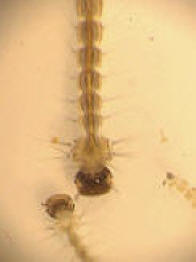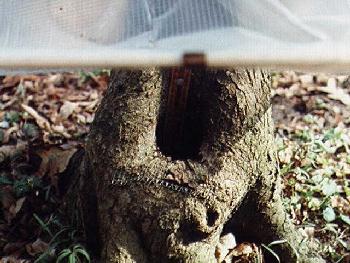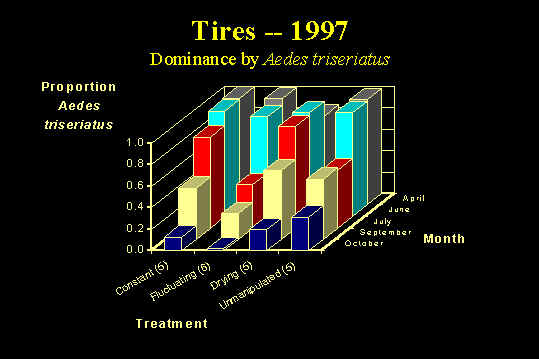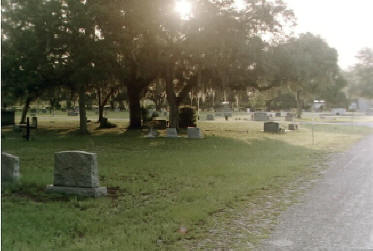Mechanisms of species replacement
updated 3 September 2006
I showed that in the field that Aedes aegypti is competitively
inferior to Aedes albopictus, particularly when food resources are scarce, even
though A. aegypti are virtually unparasitized. These results indicate that
resource competition is sufficient to account for replacement of A. aegypti, and
that shared parasites need not be involved. Gregarine
parasites do seem to affect mosquito ability, and Brianna Aliabadi (M.S.
student) and I showed that A. albopictus at recently colonized sites have
low parasite loads and improved competitive ability.
scarce, even
though A. aegypti are virtually unparasitized. These results indicate that
resource competition is sufficient to account for replacement of A. aegypti, and
that shared parasites need not be involved. Gregarine
parasites do seem to affect mosquito ability, and Brianna Aliabadi (M.S.
student) and I showed that A. albopictus at recently colonized sites have
low parasite loads and improved competitive ability.
For more details on this research topic, please see:
Costanzo, K.S., Kesavaraju,
B., & Juliano, S.A. 2005. Condition-specific competition in container
mosquitoes: the role of non-competing life-history stages. Ecology
86:3289-3295.
Braks
M.A.H., Honório N.A., Lounibos L.P., Lourenço-de-Oliveira R, & Juliano SA.
2004. Interspecific competition between two invasive species of container
mosquitoes, Aedes aegypti and Aedes
albopictus (Diptera: Culicidae), in Brazil. Annals
of the Entomological Society of America 97:130-139.
Braks M.A.H., Honório,
N.A., Lourenço-de-Oliveira, R., Juliano,
S.A. & Lounibos, L.P. 2003. Convergent habitat segregation of Aedes
aegypti and Aedes albopictus (Diptera: Culicidae) in southeastern Brazil and
Florida, USA. Journal of Medical Entomology 40:785-794
Aliabadi, B. K. & S. A. Juliano.
2002.
Escape from Gregarine Parasites Affects the Competitive Impact of an
Invasive Mosquito Biological
Invasions 4:283-297
Juliano, S. A. 1998. Species introduction and replacement among
mosquitoes: Interspecific resource competition or apparent competition? Ecology 79:255-268.
I have also been investigating variation in the outcome of this
invasion. In most of Florida, Aedes albopictus has displaced Aedes aegypti,
particularly in cemeteries, where both species colonize water-filled vases. However,
in urban areas of South Florida (Tampa, Ft. Myers, Miami), A. aegypti persists, despite
invasion by Aedes albopictus. At nearby cemeteries in suburban or rural
areas (LaBelle, Arcadia, Lakeland, Bartow), A. aegypt has gone extinct.
One hypothesis for this difference in outcome is that the impact of competition from A.
albopictus on A. aegypti is different at these urban sites, perhaps because of
differences in the aquatic environment. To test this, I have run competition
experiments at 3 cemeteries where the two coexist, and at 3 cemeteries where A. aegypti
has gone extinct following invasion byi A. albopictus. In both 1999 and
2000 the results of these experiments were similar and clear. Competition from A.
albopictus has the same effect on A. aegypti at both coexistence and extinction
sites. Thus, the difference in outcome of invasion is not a result of differences in
the aquatic environment and may be related to differences in the aerial envrionment of
adults and eggs (e.g., desiccation, host availability). Future work funded by the
NIH grant will investigate these possibilities through a combination of experiments,
modeling, and observation.
Juliano,
S.A., Lounibos, L.P., O’Meara, G.F. 2004. A field test for competitive effects
of Aedes albopictus on Aedes aegypti in South Florida:
Differences between sites of coexistence and exclusion? Oecologia
139:583-593.
Juliano,
S. A., G. F. O’Meara, J. R. Morrill, & M. M. Cutwa 2002. Desiccation and
thermal tolerance of eggs and the coexistence of competing mosquitoes.
Oecologia 130:458-469.
Effects of habitat drying on populations and communities
We have also investigated effects of food availability on population
increase in Aedes triseriatus and the effect of habitat drying and previous
resource depletion by earlier cohorts of A. triseriatus on the quality of food
resources. Andrea Aspbury and I showed that drying of the habitat had significant
detrimental effects on resource quality for Aedes triseriatus. Further, we
demonstrated that intraspecific competitive effects of A. triseriatus could be
expressed even among cohorts of mosquitoes that did not overlap in time. These effects
seem to be mediated by depletion of resources within containers.
For more details on this research topic, please see this publication:
Aspbury, A. S. & Juliano, S. A. 1998. Negative effects of drying and
prior exploitation on the detritus resource in an ephemeral aquatic habitat. Oecologia
115:137-148. © Springer-Verlag

| Along with my previous work on habitat drying and metamorphosis, these studies of
drying led to a new research direction – a project examining the effects of habitat
drying on the entire community of container invertebrates – which is a current focus
of my research. This project is involved a multi-year field manipulation of the drying
regime of natural tree holes and artificial containers (discarded tires). We monitored
abundances of 8 species of mosquitoes, about 15 species of other invertebrates (including
copepods, mites, and cladocera) in our experimental containers and ultimately will
determine the role of habitat drying and fluctuation in determining community
compostition. Our results (after 1 field season of manipulation) show that pattern of
water input to tires affects demography of A. triseriatus, the dominance of A.
triseriatus within the community, and production of pupae of A. triseriatus and
Anopheles barberi.. After two years of manipulation, we found that drying regime
affected community composition in tires late in the year, with containers that dry out
lacking predatory taxa (copepods, A. barberi, and Toxorhynchites rutilus)
and having lower species number overall. |
 |

 scarce, even
though A. aegypti are virtually unparasitized. These results indicate that
resource competition is sufficient to account for replacement of A. aegypti, and
that shared parasites need not be involved. Gregarine
parasites do seem to affect mosquito ability, and Brianna Aliabadi (M.S.
student) and I showed that A. albopictus at recently colonized sites have
low parasite loads and improved competitive ability.
scarce, even
though A. aegypti are virtually unparasitized. These results indicate that
resource competition is sufficient to account for replacement of A. aegypti, and
that shared parasites need not be involved. Gregarine
parasites do seem to affect mosquito ability, and Brianna Aliabadi (M.S.
student) and I showed that A. albopictus at recently colonized sites have
low parasite loads and improved competitive ability.

